

 Vol. 38 (Nº 55) Year 2017. Páge 27
Vol. 38 (Nº 55) Year 2017. Páge 27
Aleхandra Ivanovna ZAKHAROVA 1; Alexandra Fedorovna BORTNIK 2; Mariya Nikiforovna ROMANOVA 3; Nikolai Nikolaevich ROMANOV 4; Alla Dmitrievna NIKOLAEVA 5; Avqustina Petrovna KOLPAKOVA 6
Received: 03/08/2017 • Approved: 28/08/2017
ABSTRACT: To develop competences of future bachelors, the following three unified principles should be followed: 1) subjectness – determining the contents of bachelor training taking into account personal educational needs and fundamental requirements of FSES; 2) openness – updating on timely basis the structure (and the form) of future bachelor training under the conditions of continuously changing labor market; 3) forestalling – providing pedagogical support in the process of competence development. |
RESUMEN: Para desarrollar competencias de futuros bachilleres, deben seguirse los tres principios unificados siguientes: 1) la sujeción – determinar los contenidos de la formación de bachilleres teniendo en cuenta las necesidades educativas personales y los requisitos fundamentales de la FSES; (2) apertura – actualizando oportunamente la estructura (y la forma) de la futura formación de bachilleres en las condiciones de cambio continuo del mercado laboral; (3) previniendo – proporcionando apoyo pedagógico en el proceso de desarrollo de competencias. Palabras clave: gestión de formación profesional, competencia de licenciatura, sistema |
The analysis of cultural and historical preconditions for adopting new (third) generation Federal State Education Standards (FSES, 2011) by higher educational institutions and the development of the competences of future bachelors in line with these standards make for the possibility to undertake investigations based on methodological approaches and following the logic of the formation of the one whole within the systemic approach, of identifying the general and the specific and separating the cause from the effect.
The objective of this study is to present the results of the investigation aimed at identifying the unified system of management principles in developing competence of future bachelors.
The principal methods of the investigation are pedagogical experiment and the method of statistical processing of quantitative results. The experiment covered the 1st-3rd year students of professional education at Yakutsk State Technological University in the Republic of Sakha (Yakutia). The total number of respondents equals to 120.
The purpose of the investigation was to find out the unified system of management principles for developing competences of future bachelors.
The tasks of the investigation were as follows: consider theoretical approaches to the investigation of the problem of management in the process of developing competences of future bachelors; analyze literature and other sources on the problem under investigation; undertake pedagogical experiment specifying the experimental basis and sampling; describe the most significant results of the experiment.
The study is of current importance as it is logically accomplished with the description of the sequence of the analysis of bachelor training contents: 1) selection of initial methodological standing; 2) primary material collection; 3) identification of the elements of the system; 4) revealing the external relations between the elements of the system; 5) revealing the internal relations between the elements of the system; 6) defining the connections between the element groups; 7) identifying the general principle for developing (structuring) the new contents; 8) justifying the function of the training course (module, program, discipline).
At Bauman Moscow State Technical University, A.G. Rivin has created the conditions that enabled the students to cover the entire educational course program within just one semester. He suggested and successfully proved his own method of making students work with each other. They studied teaching each other in the so-called “managed dialogue” pairs. The members of these pairs mingled, so they were called “changing pairs”. The classes were not scheduled. However, Rivin’s method was rigorously opposed by official orthodox higher institution professors, because the method stood against formalism, authoritarianism and governmentally depersonalized system of education. At the dawn of the Soviet power, this method was so perversely “understood” that sometimes one most advanced student had to pass exams for all group. Initially this type of education was called the method of A.G. Rivin, changing pair study, ‘korninskiy” dialogue, managed dialogue, associative dialogue, “talogenism” (method for searching talents and geniuses). Later on, following V.K. Dyachenko, it was called collective way of education or democratic system of education based on abilities (DemSOS).
In 1919-1920, Higher Art and Technical Studios VKhUTEMAS (Moscow governmental higher artistic workshops for training the artists of highest qualification for industry and artist-engineers for designing room and transport interiors) in Moscow and Bauhaus in Germany were functioning as centers for generation and development of new ideas and methods of artistic design based on the combination of ideological, pedagogical and practical activities.
The idea of “labor mindsets” belonging to A.K. Gastev was embodied in the technique of professional training or in the system (method) of Central Labor Institute (TsIT, 1921-1924) that was focused on standardized, fast, programmable and large-scale training of qualified workers. The method was founded on teaching the workers certain most rational labor and production techniques dividing the operations into separate actions and movements, studying and selecting the most rational ones. Later, this idea of A.K. Gastev made basic principles of different systems of scientific labor management (NOT).
After the war, the higher artistic and industrial educational institutions in Moscow MVKhPU (former Stroganovskoye) and in Leningrad (LVKhPU named after V.I. Mukhina) were reestablished. New art and trade schools and advanced engineer courses (UIK) were opened.
The examples are numerous. Higher education is an offspring not only of the church (or, more exactly of the world religions) but also of the Western civilization; and Russia is always trying to somehow catch up with (sometimes even trying to be ahead of) this delusional, even for itself, civilization. Apparently, there is some pride to be taken in the fact that the university in Kaliningrad is named after E. Kant, although the veterans of the war stood openly against it. In Russia, there shall no longer be a professor who would start his lecture stepping on the pulpit to the peal of bells on the cathedral at 9 in the morning sharp, and the students will no longer synchronize their watches with him.
This or such professor is no longer needed in Russia. Nevertheless, we might remember M.M. Bakhtin, V.S. Bibler, L.N. Gumilev, A.F. Losev, Yu.M. Lotman, M.K. Mamardashvili, F.T. Mikhaylov, V.V. Nalimov, G.P. Shchedrovitskiy and many others, who could, by their mere presence and voice, reveal in the audience the willingness to imbibe, to take initiation into their own education, to search, to fix the unknown and then to study it.
There are some interesting facts about the genuinely Russian way of holding seminars and conferences. Naturally, they have their origins in the times of the church officers, ecclesiastical seminaries and academies that used to “sow wisdom, the good, the eternal” in the same way it was done in Western European higher education system. V.S. Bibler used to invite to his home all those who wanted to come to his seminars and it took many years before they could invite other people to their conferences. G.P. Shchedrovitskiy used to be the head of Moscow methodological study group for forty years, and later the members of this circle used to discuss at their conferences the issues they discussed earlier during their seminars.
With this regard, Yu.M. Lotman would rather have remembered not only his favorite A.S. Pushkin, but also the history of the movement of “Narodnaya Volya” (People’s Freedom), the priests’ sons, soldiers and merchants who were allowed to enter universities, the commoners of F.M. Dostoyevskiy, and, finally, Russian “intellegensia” almost entirely made of the Third Estate commoners (not of gentry or peasants). It was at these seminars that the future ideas were fashioned to go beyond the walls of university lecture rooms.
And if since the 1960s the contents of university education used to go downhill toward “physicalism”, “Soviet studies on strength of materials” exercised not necessarily in technical institutions, now, the problem of humanization of the higher education and of forming students’ general cultural competence is urgent as it has never been before. However, even nowadays, it is still too early to talk about humanization of the higher education. Today in Russia, it is neither Confucian period in China, nor 1789 in France.
In 1999, 29 European countries have signed the Bologna Declaration for creating, by 2010, a common educational environment. Russia joined the Declaration in 2003. Russian education system has never been closer to Western European system of higher education, notwithstanding all earlier efforts to adapt European educational approaches. In other words, Russian system of education was always capable of adopting the practices of the developed countries, Germany and France in the first place. Although, it is also true that after the Second World War, European (or, to be more precise, American or Anglo-Saxon) system of education was successfully customized by South Korea, Japan, Singapore, the Philippines.
At the same time, German system was the perfect choice for Russia (German university education dates back to Humboldt). Apparently, when people had to choose what every person should make of himself/herself and what the society should make of him/her then, evidently, there was an idea of creating human image from some kind of material. An educated man is a man in whom human image prevails. Religious people used to say that man was created in the image and likeness of God and there is something godlike in man. One of our greatest mentors, Feuerbach, who approached religion scientifically, was right to observe that it was not man who was created in the image and likeness of God, but rather God was created in the image of man.
Although the history of Russian education shows that there is no point in copying other people (Germans, French, Americans) all the time, present “competence development” is not just a sign of mimicry. It is a simulacrum; it is something that is the mimicry of the copies of the copies.
Before starting to discuss the creation of the two-level system of higher education or the competences or the adoption of the new (third) generation Federal State Educational Standards by the higher educational institutions, it is worthwhile remembering the cultural and historical background of such a shift when the notion of “competence” could mean those many things that have already been adopted: knowledge, skills and attainments of behaviorism; ideas of Gestalt psychology (a teaching on the integrity of processes); educational programs developed by the pedagogues of General Scientific Board (so-called GUS programs) focused on studying socially useful activities (projects) or spheres of life (complex topics) which in West Germany in early 1950s were known as instance education.
In this line of examples, special attention should be paid to scientific theoretical postulations on labor education and upbringing. Thus, the idea of M.N. Skatkin (1984) about the unified polytechnic skills enabled P.R. Atutov (2001), his successor, to justify his idea of the functional essence of polytechnic knowledge. In turn, P.P. Kondratyev (2009), a Yakut scientist, proceeds from the functional essence of educational labor of pupils in the context of labor education, from the formation of the technological environment of the labor training to the development of a universal function of pupils’ activity within the educational sphere. All mentioned above is now called competence development.
While V.N. Solovyov (2011) assumed that the theory of cognition included mystical perception and “integral knowledge” as an intuitive image-symbol perception of the world founded on the moral efforts of a personality, now many higher educational institutions are still looking for that so far delusional and almost mystical “didactic unit of knowledge”.
The thing is that the essence of any educational technique is hidden it its semiotics (signs, symbols, words, notations, patterns, etc.). Emergence of symbol-based activities, employment of the word sign as the means, as soon as those processes become internal, transform psychical life: the sign comes to be the external, auxiliary stimulus.
According to M.S. Ivanov, an efficient technological factor ensuring the application of the activity approach to engineering education is represented by the graphodynamic image of the subject (material body, technical system, object, technology, etc.) that the students shape for themselves when they organize their independent and creative activities. The author’s theoretical stance follows the postulations of a number of other researchers (T.V. Kudryavtsev, A.M. Zaltsman, I.S. Yakimanskaya, etc.) who maintain that in order to understand comprehensively the functioning system of a technical object there should appear a “dynamic image” as a system of some special purpose, and then, based on this image, comes the activity. The author proved the postulation experimentally: schematization of the image is an optimum way to store the information about the reflected object (Barakhsanova, Golikov, Nikolayeva 2016).
M.S. Ivanov (2010) highlights that in studying technical systems and technologies the students managed to attain understanding of the essence of the process as dynamic image, which was the “result” of educational modelling. Analyzing this process of modelling the author makes the following conclusions:
- images of the physical phenomena are formed from the real observable and well-known events;
- the images of the phenomena that cannot be directly observed can be designed (modelled) employing the elements of the well-known sensible images;
- iconic models are not only visible images of physical phenomena. They can be transformed; their structure and elements can be changed depending on the conditions of their existence;
- externally, the models are visually fixed as picture, drawing, schematics.
Since early 2000s, the investigations have been undertaken to form certain structures of students’ knowledge or the cognitive patterns (frames). Based on the principal theoretical postulations about stage-type development of mental activity (P.Ya. Galperin, N.F. Talyzina) and about developmental teaching (V.V. Davydov) the authors maintained that the formation of semantic (according to V.V. Nalimov) networks in educational process is not limited by the notions of professional knowledge; and that those semantic networks or structures of knowledge acquire more complex organization from linear to hierarchical in cases when categorization takes place (identification of belonging to some certain class) and when the large arrays of information come to be generalized. This generalization results in new notions and ideas, laws, theories; it implies logical operations (almost as described by J. Piaget) of comparison, classification in different forms of application of educational material: this is analysis, synthesis within the topics, sections and parts and within overall aggregate of educational material of the subject. At higher level of perception, the attributes of the whole classes of facts, events and phenomena come to be distinguished. Thus, this consequential generalizations bring students “up” to the new levels of perception of the studied events, even as high as onto the level of categories. Categorical generalization (abstraction) is, in turn, the basis of scientific and theoretical thinking. Categorical generalization makes for “new vision” of the issue.
The authors believe that categorical generalization of large arrays of information that forms complex structures of the semantic networks is only possible when a student possesses mental experience in applying the rules and patterns used in analysis, synthesis and generalization. The authors note that all ideas and notions of man (or his visual image of objects, situations, actions) are always founded on a scheme or rule, which specifies the characteristics of an object or regularities of an action, i.e. there is a plan and a method for storing, structuring and combining the information. The more such schemes are available to a student, the better his mental capabilities are revealed. Thus, the cognitive scheme is a generalized stereotyped form of storing experience in strictly determined subject area (sign object, known situation, conventional sequence of events, etc.).
In this study, the authors considered three types of general cognitive schemes initially distinguished by a number of other researchers (M.A. Kholodnaya, Ye.I. Vovk, J.A. Pascual-Leone):
- figurative. They are in charge for recognizing familiar objects and events. For example, “prototype”, a combination of the most typical sensor-visual attributes stored in the memory and enabling decisions about the correlation between certain object and that or another category;
- operative. They set the rules for transforming the data. For example, “frames”, schematized ideas about that or another stereotypical situation that consist of common “frame” reproducing stable characteristics of the situation and “nodes” that are sensitive to its probable characteristics and can be filled with new data; “deeper semantic and syntactic universalization”, basic language structures predetermining the nature of usage and understanding of signs of language in real speech activity; “hierarchical perceptive schemes”, multilevel cognitive structures organized in the form of a hierarchical network and featuring the space images of the objects including the global (symmetry, closeness, compactness, etc.) and detailed ones (red, two angles, etc.);
- managing. They are in charge for plans of actions in a problematic situation. For example, the scheme “cognitive map”, the image of the familiar environment; “scenarios” covering the patterns of actions a man usually follows. These are cognitive structures facilitating the reproduction of temporal sequence of events.
In terms of educational methodology, there is a postulation of P.Ya. Galperin on the orientation basis as an image of the environment and as an image of action. This basis is used to manage actions.
The undertaken comparative analysis of theoretical postulations shows that many investigators work in the same direction but follow different paths. In due time, many theoretical postulations have to be revised from the perspectives of modern realities specific for the sphere of education.
In the system of education in Russia, there has been a consistent idea about the creation of school for children (paradoxically as it may be, we still have to remember the period of “children-free pedagogy”), commune schools, “child’s socialism”: N.P. Ogarev (model of peoples’ polytechnical school (Ecole Polytechnique Populaire)), A.U. Zelenko, S.T. Shatskiy (method of projects), M.N. Skatkin, P.R. Atutov (methods of problem-based teaching), M.P. Shchetinin, V.K. Dyachenko (cooperative pedagogy).
Chapter 2 text Experimental base of the investigation: Yakutsk Institute of Engineering and Technology. Sampling was taken among the 1st-3rd year bachelor students. The total number of respondents equals to 120.
The issue of structuring the contents of future bachelor education in the context of developing their competences is associated with the need to resolve the following contradictions:
- contradictions between the former and the nascent understanding of the essence of competence. Our idea about competence is evidently in the state of collision, metamorphosis, transformation toward, finally, our Russian (not the old-world) understanding, when a person is considered competent not only when he/she is capable of something, but when he/she does everything properly to meet the needs; and, probably, not to meet his/her own needs, but rather the needs of other people who make some certain society. Otherwise, the person is not competent;
- contradictions between general and individual approaches to bachelor education. Due to reconsidering the essence of the competence (associated with the first contradiction), there is the need to select methodological bases to define competence of future Russian bachelors. They should be either competent and do everything properly or incompetent but capable of personal choice.
In this study, the following schematics of the experiment shall be selected as methodological approach:
1. Following the logic of forming the one whole in the systemic approach (for example, what should the students study and how should they master the integral idea of education as of live and constantly developing process; how should they turn mere memorizing of separate scientific postulations and foundations into the dialectic process of adoption proceeding from the concrete to the abstract, from simple to complex; how should they perceive the inseparability of life and education). This approach is often reduced to finding out the systemically important original principle.
2. This cornerstone principle, in this case, includes the idea of a system as of something that consists of different parts. The connections (dependences) between these parts are predetermined by the functions of this system (the initial functions are shifted to the scope of mission of the higher educational institutions, etc.). Following this principle and based on the development of the concept (problem, topic, concept, idea, hypothesis) it is possible to construct the model (variant, likeness or miniature) and then to list the conditions that could enable practical implementation of this model.
3. Identifying the general and the specific (internal differentiation among young students, peculiarities of each category of rural or urban youth). This approach is neither clear nor precise.
4. Separating cause (conditions) and effects (the worldview and educational stance in students’ training). This approach is seldom applied.
Sometimes, to model the new system, one has to proceed in the reverse order: if the functions (f) of the future system (competences in this case) are initially given, then the way to the parts (n) of the system (principal structural units of bachelor education: disciplines of the curriculum, educational programs, etc.) goes through revealing the connections (s) between these elements. Thus, there is a function with at least two unknown variables: f (n, s).
It is, of course, possible to set something as priority (for example, competences), but it is still better to find out the methodological foundations. Otherwise, the unclear “arithmetic” of the number of competences, among other things, will go on.
The problem of the implementation of the 3rd generation FSES, including “FSES 3+” (or even “FSES 3++”) in the context of bachelor education, among other well-known aspects (different higher education standards, academic or applied bachelor’s degree program, activities of the subject of education, his/her developing competences) acquires its methodological justification which can be termed as the definition of the system when this system includes the elements (parts, components) whose interconnections predetermine the functions of this system.
Within the framework of the study, a questionnaire survey has been undertaken among 1st-3rd year future technical bachelors. The questionnaire included five questions. Each of three optional answers to every question was to be evaluated with up to 10 points in order to determine the attitude of the respondents toward the degree of development of their competence. Mean arithmetic values of the choices among the optional answers are given below.
For the first question “Is it possible to combine the esthetic and the utilitarian in every manufactured item?” the maximum fell on option “А” (“Yes, if the combination is based on profound knowledge of art and technology”). Thus, it is evident that the possibility to combine the esthetic and the utilitarian in every manufactured thing is understood during senior years of study, which, in turn, shows the development of competences in general.
Diagram 1. Resulting answers to question 1 of enquiry
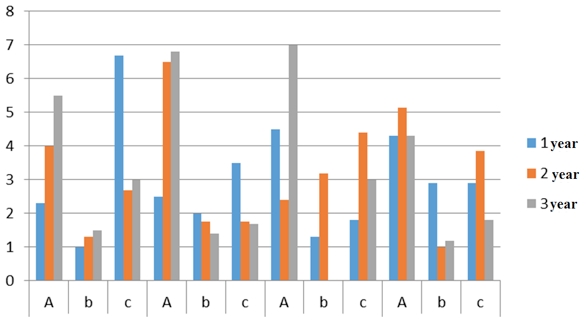
Source: compiled by the authors.
For the second question “How should we estimate amateur art and the things related to officially recognized art?” the maximum fell on option “А” (“Things related to officially recognized art have been selected by professionals”). The answers to the second question show that the majority of the respondents adhere and will adhere to general official opinions, which can be taken into account during the development of educational programs, etc.
Diagram 2. Resulting answers to question 2 of enquiry
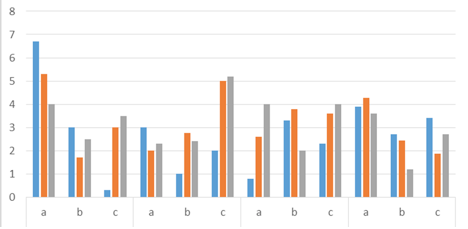
Source: compiled by the authors.
For the third question “What is your attitude toward the evaluation of the nationally styled items?” the maximum fell on option “B” (“These are not only decorations, but also different souvenirs in a national style”). This choice shows certainty in the answers of the 3rd year respondents and indicates the level of competence development.
Diagram 3. Resulting answers to question 3 of enquiry
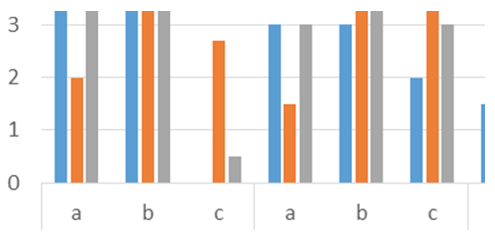
Source: compiled by the authors.
------
Diagram 4. Resulting answers to question 4 of enquiry
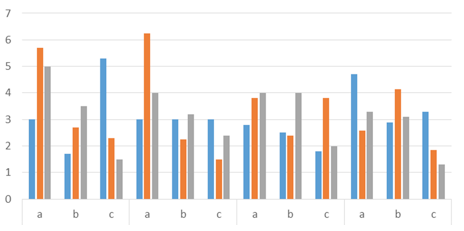
Source: compiled by the authors.
-----
Diagram 5. Resulting answers to question 5 of enquiry
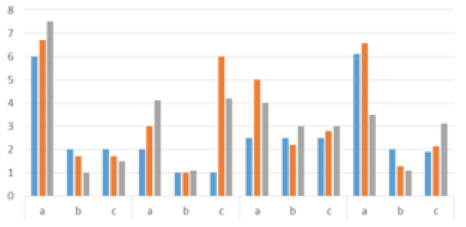
Source: compiled by the authors.
For the fourth question “The principles of design may be as follows” and for the fifth question “How do you think traditional trade transforms into modern technology?” the maximums fell, expectedly, on option “А”. Such answers prove to be the most valuable from the perspectives of the necessity to develop certain competences.
The analysis of the answers makes it possible to identify the following specifics of competence development process:
- the majority (over 50%) of the respondents adhere and will adhere to generally accepted definitions and official positions, which can be taken into account during the development of educational programs, etc.
- certainty in the answers of the respondents may indicate the level of competence development;
- the expected maximum of the selected option proves to be the most valuable from the perspectives of the necessity to develop certain competences;
- competence is developed year on year;
- the possibility to combine the esthetic and the utilitarian in every manufactured thing is understood during senior years, which, in turn, shows the development of general technological competences.
In all, the answers to the questions have proved our suggestions as regards the possibility to select a particular competence based on the analysis of the answers to various questions. Consequently, in future it will be possible to consider the integrity, the aggregate of the general and of the specific and individual in bachelor education.
The undertaken investigation shows that to determine any competence the following principles should be followed:
1) subjectness – determining the contents of bachelor education taking into account personal educational needs and the fundamental requirements of FSES; thereat, it should be remembered that changing the meaning of the action also changes the impetus for this action;
2) openness – under the conditions of continuously changing labor market bachelor education curriculum should be updated on timely basis keeping in mind the fact that the external reasons always act through internal conditions;
3) forestalling – pedagogical support in the process of competence development without forgetting the fact that the formation of new type of activity should not exclude the previous one.
The experiment undertaken in the study is logically accomplished with the description of the sequence of the analysis of bachelor education contents:
1) selection of the initial methodological standing;
2) primary material collection;
3) identification of the elements of the system;
4) revealing external relations between the elements of the system;
5) revealing internal relations between the elements of the system;
6) defining the connections between the element groups;
7) identifying the general principle for developing (structuring) the new contents;
8) justifying the function of the training course (module, program, discipline).
The abovementioned sequence shows that every system is composed of the elements whose interconnections (external and internal) predetermine the functions of this system.
The internal and the external are in continuous interaction founded on the opposition of the efforts of stability and variability. Therefore, the nature of the interaction between the internal and the external indicates the necessity of their constant transformation. Thereat, it should be remembered that the external reasons always act through internal conditions (according to S.L. Rubinstein).
To identify the specific elements that make (or will make) that or another system (competence development in this case), the modelling of this system can be traced back to the functions, to the things we expect from this system. Thus, in future it will be possible to consider the integrity, the aggregate of the general and of the specific and individual in bachelor education.
Atutov, P.R. (2001). Pedagogy of the labor student formation: meaningful procedural framework. Selected works in 2 volumes. Vol. 1. Moscow: Idol, 360 p.
Barakhsanova, E.A., Golikov, A.I., Nikolaeva, A.D. (2016). The Internet and Future Teachers of Yakutia: Analysis of Research Results for the Period from 2011 to 2015. Indian Journal of Science and Technology, 9(11), 2-5.
FSES. (2011). Federal State Standard for General Primary Education. The Ministry of Education and Science of the Russian Federation. Moscow.
Ivanov, M.S. (2010). Pedagogical application of the activity approach to train competent agricultural engineers: PhD thesis. Yakutsk: M.K. Ammosov North-Eastern Federal University, 160 p.
Kondratyev, P.P. (2009). Development of universal functions of pupils’ activity in educational environment. (Satalogy). Yakutsk: Institute for professional training of teachers named after S.N. Donskoy-II, 344 p.
Skatkin, M.N. (1984). Problems of modern didactics. 2-Ed. Moscow: Pedagogy, 96 p.
Solovyov, V.N. (2011). Philosophical foundations of the whole knowledge. Moscow: Academic project, 383 p.
1. Department of Pedagogy, North-Eastern Federal University named after M.K. Ammosov, Yakutsk, Russia. zaaliv_06@mail.ru
2. Department of Pedagogy North-Eastern Federal University named after M.K. Ammosov, Yakutsk, Russia. aleksabortnik@mail.ru
3. Department of Pedagogy, North-Eastern Federal University named after M.K. Ammosov, Yakutsk, Russia. rmnikif@mail.ru
4. Department of Pedagogy, North-Eastern Federal University named after M.K. Ammosov, Yakutsk, Russia. nikolrom58@mail.ru
5. Department of Pedagogy, North-Eastern Federal University named after M.K. Ammosov, Yakutsk, Russia. allanikol@list.ru
6.Department of Pedagogy, North-Eastern Federal University named after M.K. Ammosov, Yakutsk, Russia. Kolpakova_ap@mail.ru